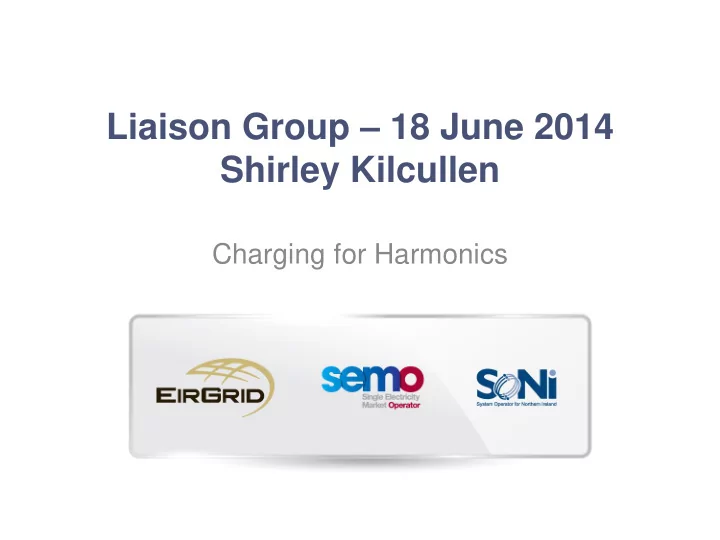

Liaison Group – 18 June 2014 Shirley Kilcullen Charging for Harmonics
What is Connection Charging • Recovery of “shallow” connection asset capital costs associated with customer connections. • Focuses on transmission assets required up to the meshed system. • Governed by a number of policy documents which set out high level principles for the assigning of costs.
Connection Charging: Basics • Focus on determining causation and drivers of specific works. • Charging applied on an LCC basis. • Assets which are not driven exclusively by a given customer/subgroup are considered “deep” and recovered via TUoS tariffs. • Assets which are driven exclusively by a given customer/subgroup even if considered “deep”, should be paid for by the customer/subgroup. • Rebates - payable where customers connect to assets which were funded by pre-connected parties.
Harmonics issues in a charging context • Per policy, customers should be charged for deeps required to mitigate against harmonic issues arising due to CP UGC. • If harmonic solutions are optimised on a geographic basis, are deep in the system and mitigate harmonics for a number of applicants, assigning causation and apportioning the cost of these solutions within SG’s is v difficult.
Considerations • The charging approach needs to: – Be fair and proportional. – Send a signal about the cost that cable requests impose on the system and inform customer decision making on that basis. – Be relatively simple to apply - not requiring a suite of “charging” power quality studies. – Be robust and enduring - not just solve issues with current Offer Process modifications. – Protect the interests of the TUoS customer.
Options being considered
Option 1: Charge for the actual solution implemented • Actual solution implemented charged in its entirety on the basis of out-turn cost. Pro: • Entirely cost reflective – TUoS fully protected. Pro/Con: • Potential for optimisation but could impose undue inflexibility & cause delays. Cons: • Extremely complex - v difficult to assign causation. • Rebating issues. • In SG, if a party “falls away” – TUoS wouldn’t cover their share of charges for harmonics.
Option 2: Apply a Least Cost approach • Apply an LCC type approach – e.g. std charge for a filter bank at the point of connection to the meshed system where the connection exceeds harmonics limits. Pros: • Consistent with the LCC principle, pay for the lowest cost solution to the problem, regardless of what is ultimately installed. • Charge more predictable. Pro/Con: • Same optimisation considerations as Option 1. Cons: • Same issues as for Option 1. • Potential TUoS exposure.
Option 3: Apply a harmonics levy • Apply a levy on all customer requests for cable on a per km UGC basis. Pros: • Reflects that harmonics issues are cumulative. • Clear & transparent - avoids rebating and SG cost allocation issues. Cons: • Customers that request cable in an area of low underlying harmonics would pay the same as in high areas, unless a “postcode” approach was applied. • € per km levy = a function of a number of variables each of which has potential for inaccuracy. • V difficult to derive an accurate € per km levy without time limits for customer requests for UGC.
Option 4: Recover via TUoS Pros: • Ease of implementation. • Recognises cumulative nature of harmonics issues. • No rebating required or issues with assigning causation. Cons: • Shields customers requesting UGC from full incremental cost. • Totally misaligned with principle of Clause 5.4 of the CMS.
Proposed scope • Apply charging decision – – To all customers who have already been put on notice re this issue via holding statements in their connection agreements and – To all customers who request UGC after the date of publication of the harmonics consultation paper (13/06/14)
Next steps Comments welcome re 4 charging options and any alternatives by 18/07/14
Recommend
More recommend